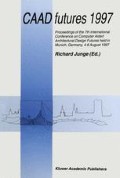Abstract
A model of human-machine design interaction is presented. The model is based on synchrony of actions [Mitchell95a] as it relates to designing, presenting, and discussing a design object over an electronic medium. The model descriptively accommodates existing technologies and areas of CAD research. The model prescriptively illuminates future CAD vis. the Web. The model is based on 3 factors: synchrony, presence, activity; and 2 players: human and machine. Future technologies are considered in terms of the a shifting role of the machine (the computer and the net) from server to agent to actor.
Access this chapter
Tax calculation will be finalised at checkout
Purchases are for personal use only
Preview
Unable to display preview. Download preview PDF.
References
Andrew Ames, David Nadeau, John Murphy. (1996) The VRML Source Book, John Wiley, NY.
Barrett, E. (ed.) (1992) Sociomedia: Multimedia, Hypermedia, and the Social Construction of Knowledge. MIT Press. Cambridge
Bly, S. (1988) “A use of drawing surfaces in different collaborative settings.” In Proceedings of the Conference on Computer-Supported Cooperative Work (CSCW’88), p 250–256, Portland, Oregon, September 26–28, ACM Press.
Bush, V. (1945) “As We May Think” Atlantic Monthly, July
Grady Booch. (1994) Object-oriented Analysis and Design with Applications, Benjamin/Cummins, Redwood City, Calif.
Engeli, Kurmann, Schmitt (1995) A New Design Studio, Intelligent Objects and Personal Agents in Virtual Environment, in Acadia 1995.
Katz, R., E. Chang, R. Bhateja. (1986) “Version Modeling concepts for Computer-Aided Design Databases”. Submitted to ACM SIGMOD Intl. Conf. On Management of Data.
Kay, Alan (1984): Computer Software. Scientific American 251 (3, September), 53–59.
Kim, SungAh (1997) Version Management in Computer-Aided Architectural Design. Thesis, accepted by Harvard University Graduate School of Design, Feb. 1997.
Maes, Partie (1994): Agents that Reduce Work and Information Overload. Communications of the ACM 37 (7, July), 31–40.
Maes, Pattie; Kozierok, Robyn (1993): Learning Interface Agents. In: Proceedings of AAAI’93 Conference Washington, D.C. July 1993. 459–465.
Minsky, Marvin (1985): The Society of Mind. Simon & Schuster, New York. 339 pages.
Mitchell, W. J. (1995) The City of Bits. MIT Press. Cambridge
Mitchell, W.J., McCullough, M., (1995). Digital Design Media. Van Nostrand Reinhold New York:. 2nd ed.
Russell, S., Norvig, P. (1995). Artificial Intelligence, Prentice Hall, NY.
Simon, A. R., (1995). Strategic Database Technology, Morgan Kaufman Publishers, San Francisco, CA.
Turing, A. M. (1936). Computing Machinery and Intelligence. Mind, 59:433–460.
Wojtowicz, J. (ed.) (1995). Virtual Design Studio, Hong Kong University Press. Hong Kong
References
http://www.cnet.com/Content/Reviews/Hands/012797/ra30.html; also see other internet audio streaming at http://www.yahoo.com/Computers_and_Intemet/Software/Internet/World_Wide_Web/Browsers/Pluglns/SoundandVideo
http://www.ncsa.uiuc.edu/General/Internet/WWW/HTMLPrimer.html
http://www.w3.org/pub/WWW/MarkUp/
http://www.w3.org/pub/WWW/Protocols/
Author information
Authors and Affiliations
Editor information
Editors and Affiliations
Rights and permissions
Copyright information
© 1997 Springer Science+Business Media Dordrecht
About this paper
Cite this paper
Tsai, D.E., Kim, S. (1997). Human — Machine — Design Matrix. In: Junge, R. (eds) CAAD futures 1997. Springer, Dordrecht. https://doi.org/10.1007/978-94-011-5576-2_31
Download citation
DOI: https://doi.org/10.1007/978-94-011-5576-2_31
Publisher Name: Springer, Dordrecht
Print ISBN: 978-94-010-6350-0
Online ISBN: 978-94-011-5576-2
eBook Packages: Springer Book Archive

